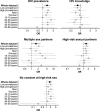Industrial mining and HIV risk: evidence from 39 mine openings across 16 countries in sub-Saharan Africa
- PMID: 35730379
- PMCID: PMC9451919
- DOI: 10.1097/QAD.0000000000003294
Industrial mining and HIV risk: evidence from 39 mine openings across 16 countries in sub-Saharan Africa
Abstract
Objectives: The aim of this study was to assess the impact of natural resource extraction projects on HIV transmission risks in local communities in sub-Saharan Africa.
Design: Difference-in-differences design using repeated cross-sectional data from around newly opened mines.
Methods: We combined data on mine openings with HIV data from the Demographic and Health Surveys (DHS). Using logistic regression models, we compared HIV-related indicators between mining (i.e. up to 10 km distance from the mine) and comparison (i.e. 10-50 km) areas before and after mine opening to identify their impact on HIV prevalence, sexual behavior and HIV knowledge.
Results: A total of 33 086 individuals across 39 mine openings were analyzed. Adjusting for baseline differences and temporal trends in the study regions, mine opening increased the odds of HIV infection almost two-fold [odds ratio (OR): 1.93, 95% confidence interval (CI): 1.19-3.14]. Strongest effects were seen in high-prevalence countries and in the 20-29 years age group. In mining communities around operational mines, there was a tendency towards lower HIV knowledge (OR: 0.81, 95% CI: 0.63-1.04). New mine openings increased the odds of risky sexual behaviors, such as having multiple sex partners (OR: 1.61, 95% CI: 1.02-2.55), high-risk sexual partners (OR: 1.45, 95% CI: 1.03-2.05) and unprotected sex with high-risk partners (OR: 1.77, 95% CI: 1.18-2.67).
Conclusion: The findings suggest that in our sample of households surrounding industrial mines, HIV infection risks substantially increase upon mine opening. Existing strategies for addressing mining-related risks for HIV transmission seem to be insufficient. Further efforts for mitigating and monitoring impacts of mines are needed.
Copyright © 2022 The Author(s). Published by Wolters Kluwer Health, Inc.
Conflict of interest statement
There are no conflicts of interest.
Figures



Similar articles
-
Pooled prevalence, spatial variation and associated factors of HIV testing uptake among multiple sexual partners in Sub Saharan Africa: Spatial and multilevel analysis.PLoS One. 2024 Jul 11;19(7):e0306770. doi: 10.1371/journal.pone.0306770. eCollection 2024. PLoS One. 2024. PMID: 38990916 Free PMC article.
-
Human immunodeficiency virus and migrant labor in South Africa.Int J Health Serv. 1991;21(1):157-73. doi: 10.2190/11UE-L88J-46HN-HR0K. Int J Health Serv. 1991. PMID: 2004869
-
Sexual risk of HIV infection among expatriates posted in AIDS endemic areas.AIDS. 1997 Jul 15;11(9):1173-81. doi: 10.1097/00002030-199709000-00014. AIDS. 1997. PMID: 9233466
-
AIDS in sub-Saharan Africa: the epidemiology of heterosexual transmission and the prospects for prevention.Epidemiology. 1993 Jan;4(1):63-72. Epidemiology. 1993. PMID: 8420583 Review.
-
Risky Sexual Behavior across Extremes of Wealth in sub-Saharan Africa: A Meta-Analysis of Demographic and Health Surveys.Ethiop J Health Sci. 2021 Jan;31(1):159-166. doi: 10.4314/ejhs.v31i1.18. Ethiop J Health Sci. 2021. PMID: 34158763 Free PMC article. Review.
Cited by
-
Exploring the Impact of Mining on Community Health and Health Service Delivery: Perceptions of Key Informants Involved in Gold Mining Communities in Burkina Faso.Int J Environ Res Public Health. 2023 Dec 12;20(24):7167. doi: 10.3390/ijerph20247167. Int J Environ Res Public Health. 2023. PMID: 38131718 Free PMC article.
-
Patterns of Rising HIV Positivity in Northern Madagascar: Evidence of an Urgent Public Health Concern.Trop Med Infect Dis. 2024 Jan 11;9(1):19. doi: 10.3390/tropicalmed9010019. Trop Med Infect Dis. 2024. PMID: 38251216 Free PMC article.
-
Safeguarding global health security amidst a scramble for Africa's minerals for the clean energy transition.Global Health. 2025 Apr 27;21(1):24. doi: 10.1186/s12992-025-01102-x. Global Health. 2025. PMID: 40289094 Free PMC article.
-
Exploring prioritization of wellbeing and health impacts for mining communities during the mining life cycle within the sub-Saharan Africa context: a systematic review.BMC Public Health. 2025 Apr 16;25(1):1432. doi: 10.1186/s12889-025-22691-7. BMC Public Health. 2025. PMID: 40241020 Free PMC article.
-
The Nexus of HIV, substance abuse, and mental health among adolescents in Zambia (2021-2023).J Public Health Afr. 2025 Apr 30;16(1):1229. doi: 10.4102/jphia.v16i1.1229. eCollection 2025. J Public Health Afr. 2025. PMID: 40356736 Free PMC article.
References
-
- UN. Transforming our world: the 2030 Agenda for Sustainable Development. New York: United Nations; 2015.
-
- ICMM. Good practice guidance on HIV/AIDS, tuberculosis and malaria. London, UK: International Council on Mining and Minerals; 2008.
-
- IFC. Projects and people: a handbook for addressing project-induced in-migration. Washington DC: International Finance Corporation; 2009.
Publication types
MeSH terms
LinkOut - more resources
Full Text Sources
Medical

